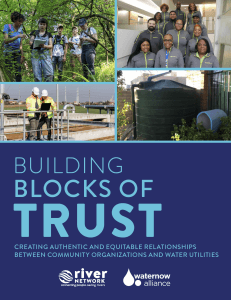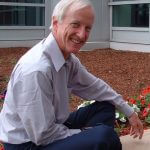Caroline Koch
This interview was conducted by Carly Schmidt on October 28, 2021, with minor updates published on December 6, 2022. Learn more about Caroline’s work at https://waternow.org/.
Transcript
What does it mean to be the water policy director at WaterNow Alliance?
WaterNow is a membership-based nonprofit where our members are local elected or appointed officials, government, and utility executive management and staff, and really anyone raising their hand and voting on water issues. We focus on this group because 95% of spending on local water management, infrastructure, and planning happens at the local level. We have about 700 members in 43 states, with a large contingent in California and Colorado.
My role as the water policy director is to identify and help to clear legal and policy barriers to our members’ work to advance sustainable options in their communities. This can happen at the local level as an ordinance that doesn’t necessarily accommodate green infrastructure to the federal level, making sure that infrastructure policy includes sustainable water solutions.
What is your background and how long have you been with WaterNow Alliance?
I’ve been at WaterNow for four and a half years. I’m an attorney—a recovering litigator, as I like to say—and I spent the first 10 years of my career representing environmental nonprofits, mostly in Clean Water Act compliance cases. These cases focused mainly on addressing stormwater pollution, wastewater, combined sewer overflows, as well as industrial stormwater runoff. As 99% of that work was about solving water challenges, I realized it was time for me to shift away from litigation and focus on those solutions at WaterNow. We like to say yes to things and clear barriers for folks who want to implement more sustainable options.
WaterNow and River Network recently collaborated on a project to develop best practices for building trust with water utilities. What did you learn from this research?
This project brought together community groups in River Network’s membership and the local governments in the WaterNow network to find examples of partnerships that have been successful in either overcoming a lack of trust or establishing a long-running partnership. We interviewed utilities and community groups involved in nine partnerships total to compile a document of best practices to share with both our networks.
We learned so much from all of these partnerships. For example, several years ago now, the Santa Cruz Water Department was considering desalination to address their water supply limitation and the community was not on board. There was a lot of distrust between the water utility and the community, but they were able to turn it around through a really robust stakeholder process. It included the utility as well as a third-party facilitator. In the end, they came up with a really great strategic plan that incorporated adaptive management and community input along the way. I’m excited to share this partnership in particular because it’s a fantastic example of this collaboration. They started from a place of distrust but had the foresight to pause the project and come up with new solutions.
Over the past two years, River Network and WaterNow have continued our partnership to pilot the trust building best practices and support on the ground organizations and their utilities as they strengthen their relationships. So far we’ve worked with six partnerships. Through these pilots the partnerships are implementing tangible projects like engaging youth in watershed protection, installing trash capture systems, holding a community water summit, and demystifying lead service line replacement programs. They’ve also fostered more intangible elements of trust like breaking the ice to regular conversations, creating new understanding about the inner workings of utilities, and highlighting community values and priorities.
Did you find that it was typical for water utilities and communities to be receptive to these collaborative solutions?
It’s challenging because some utilities or community groups do start from a place of distrust while others have more long-standing relationships. There’s really a range of trust levels at the outset of a community-scale project. For utilities, some see their community as an important part of their mission and the work that they’re doing, so they take on engagement and community outreach. We see a lot of success in utilities who see their mission as something broader. They see themselves as an anchor institution in the community. For example, they’re providing clean drinking water but also jobs and ways to engage.
The Water Champions program in Cleveland, Ohio, is a good example of a community group partnership with two water utilities. They are relying on nonprofits and community groups to implement their work through contracts. This program brought CHN Housing Partners, the Northeast Ohio Regional Sewerage District, and Cleveland Water together to form this liaison effort to get more people signed up for their bill assistance programs. This utility recognized that they needed a trusted face out in the community in order to get people to sign up for the program but also to initiate a two-way conversation about other issues the community is facing.
It sounds like these partnerships are mutually beneficial in a really meaningful way. Was there a case study or finding that really surprised you as you were doing this research?
You’re right about the mutually beneficial piece. One of the best practices is identifying shared goals and exploring how reaching these goals would provide a mutual benefit. But that wasn’t necessarily surprising. Some of the case studies and leaders we heard from were very illuminating. We always say “meet people where they are,” but it’s not always clear what that means in a local context. An example of this is in New Orleans, there’s a local interest in keeping front lawns paved. It’s a really interesting challenge because the utility and community groups are trying to mitigate flooding in the area and introduce some green infrastructure solutions, most of which mean that front lawns should not be paved. This example really showed us the importance of having goals really centered around local perspective by working with community needs and values.
And New Orleans was one of our trust building pilots. In line with neighborhood needs, together with the Sewerage and Water Board of New Orleans two nonprofits, Healthy Community Services and Greater Treme Consortium, installed what’s called a “litter gitter” in a local canal and took residents on a tour of the pump station that serves their neighborhood. The project helped open the lines of communication with the neighborhood and demonstrate the complexity of the water system all while building ways for the community to reduce trash.
Aside from this research and the toolkit, what are you and WaterNow focused on at the moment?
Helping leaders view distributed (or localized) infrastructure as a real solution. We’re talking about water use efficiency, turf change outs, onsite reuse, gray water systems, smart irrigation controllers, rain barrels, and bioswales—projects and solutions that supplement and extend the more conventional, centralized systems. We’re working to bring these more sustainable solutions to scale and get more of these capital investments happening. We’re working directly with a few communities and helping them navigate their questions. One of the challenges is that this is a hyper-local issue, so there can be a lot of barriers through rules on where communities can and cannot spend public dollars. Another challenge is getting the federal government to stop recognizing state or local rebates for water efficiency, green infrastructure, or reuse as taxable income. But this is really about helping communities bring these investments to scale and treating them as infrastructure.
What is the rationale behind the concept of distributed infrastructure?
Distributed infrastructure can be so much more resilient and equitable for communities, and these solutions can be implemented quicker. These solutions cannot completely replace conventional gray infrastructure, but it can help supplement these systems. For example, in Spanish Fork, Utah, they were experiencing deep droughts and the peak demand for outdoor watering was exceeding the capacity of their reservoir. The proposed solution was buying more water and a new pipeline. But, as an alternative, they decided to deal with the peak demand issue through smart irrigation controllers. Everyone who wanted one got a free controller and they staggered the watering. It deferred the need to buy new water, and they are expanding the solution to further delay the need for a pipeline. And, because these options are distributed, you can site them more strategically and focus on historically under-resourced communities. Expanding our view of what infrastructure is advances WaterNow’s goal of creating more affordable and equitable options.
About
Caroline Koch, WaterNow Alliance Water Policy Director, leads the organization’s work in identifying and addressing policy and legal barriers to implementation of sustainable water management practices through toolkit development, legislative and administrative advocacy, and policy white papers. She was previously a partner at Lawyers for Clean Water, Inc. representing environmental non-profit organizational clients in federal citizen suit actions and impact litigation advocating for the protection of California’s water and public trust resources. Caroline serves on the San Francisco League of Conservation Voters Board. She graduated with a BA in English and Public Policy from Duke University and a JD with honors from Golden Gate University School of Law, with a Certificate in Environmental Law.







